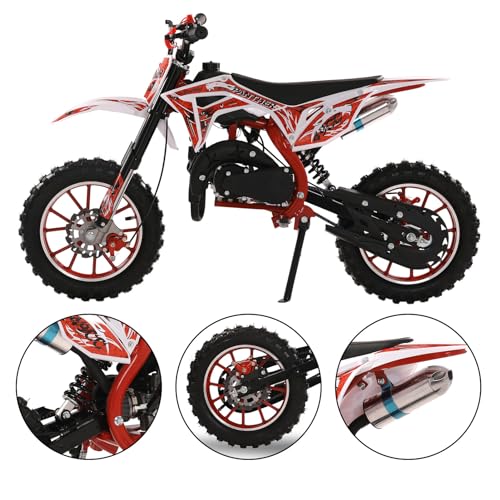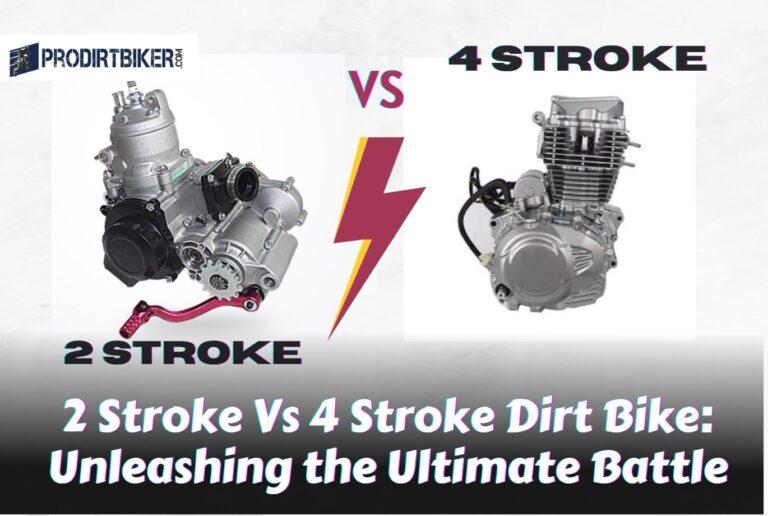Why Are Dirt Bikes So Expensive? Uncovering the Cost Factors

Dirt bikes are expensive due to the high cost of manufacturing and specialized components that make them suitable for off-road use. Dirt biking is an exhilarating sport that brings out the adventurous spirit in riders.
The sight of these powerful machines roaring through rugged terrains is enough to ignite the excitement in anyone’s heart. However, one cannot help but wonder why dirt bikes come with such a hefty price tag. The answer lies in the intricacies involved in their manufacturing and the specialized components that make them capable of conquering off-road challenges.
From the engine to the suspension and the frame, every part is meticulously designed and crafted to withstand the extreme demands of off-roading. In this article, we will delve deeper into the reasons why dirt bikes are so expensive, shedding light on the factors driving up their price and how they contribute to the overall exhilaration of the sport. So, let’s rev our engines and explore the world of dirt biking and its price dynamics.
Why Are Dirt Bikes So Expensive?
Dirt bikes are expensive due to the high cost of manufacturing and specialized components that make them suitable for off-road use. Dirt biking is an exhilarating sport that brings out the adventurous spirit in riders.
Dirt biking is a thrilling and adventurous sport enjoyed by millions around the world. Whether you’re a professional racer or a weekend warrior, one common concern often arises: the high price tag attached to dirt bikes. The cost of dirt bikes can be a significant barrier for many enthusiasts, leading to the question: Why are dirt bikes so expensive? In this article, we will delve into the various factors that contribute to the steep price of dirt bikes.
- Research and Development
Designing and developing a dirt bike is an intricate and time-consuming process that requires a significant financial investment. Manufacturers invest heavily in research and development (R&D) to create bikes that are high-performance, safe, and durable. Engineers and designers work tirelessly to optimize frame designs, suspension systems, engines, and other components. Cutting-edge technology and materials are often used, all of which add to the overall cost.
- High-Quality Materials
Dirt bikes are built to withstand the rigors of off-road riding, which can be incredibly demanding on the machine. As a result, they are constructed using high-quality materials that are both durable and lightweight. Components like frames, swingarms, and engine parts often use materials such as aluminum, titanium, and carbon fiber. These materials are not only expensive but also require specialized manufacturing processes, driving up the overall cost.
- Engine Technology
The heart of any dirt bike is its engine, and dirt bike manufacturers invest heavily in developing and producing powerful and reliable engines. Advanced engine technology, such as four-stroke engines with fuel injection systems, enhances performance while meeting increasingly stringent emissions standards. These sophisticated engines are expensive to design, manufacture, and maintain, contributing significantly to the bike’s overall cost.
- Suspension Systems
Dirt bikes need robust suspension systems to handle rough terrain effectively. High-end dirt bikes often feature adjustable suspension components, such as inverted forks and rear shocks, which are engineered to provide a smooth and controlled ride over obstacles. The research, development, and production of these components add to the bike’s cost, as does the ongoing maintenance required to keep them in top condition.
- Brand Reputation
Well-established dirt bike manufacturers often command higher prices due to their reputation for quality, performance, and innovation. Buyers are willing to pay a premium for a brand that has a history of success in the sport. The value of a recognized brand name adds to the overall cost of the dirt bike.
- Customization Options
Dirt bike enthusiasts often seek customization options to tailor their bikes to their specific needs and preferences. Manufacturers offer a wide range of aftermarket parts and accessories, which can significantly increase the cost of a dirt bike. From exhaust systems to graphics kits, the ability to personalize a bike comes at an added expense.
- Racing and Competition
Professional dirt bike racing is a highly competitive sport, and manufacturers invest in racing programs to showcase their bikes’ capabilities. These programs involve extensive testing, development, and support for professional riders and teams. The costs associated with racing directly impact the price of production bikes.
- Safety Features
Safety is paramount in the world of dirt biking, and modern dirt bikes come equipped with various safety features. These can include advanced braking systems, traction control, and rider aids like electronic fuel injection. Ensuring rider safety adds to the complexity and cost of dirt bike manufacturing.
- Import Costs and Tariffs
Many dirt bikes are manufactured overseas and imported to different countries. Import tariffs, taxes, and shipping costs can substantially increase the price of a dirt bike. Economic factors and trade agreements also play a role in determining the final cost.
- Regulatory Compliance
Dirt bikes must adhere to various regulations and safety standards set by governmental authorities. Meeting these standards requires extensive testing and certification, which can be time-consuming and costly. Manufacturers invest in research and development to ensure that their bikes meet not only safety and environmental regulations but also quality and durability standards.
- Limited Production Runs
Dirt bike production often involves limited runs of specific models. Unlike mass-produced consumer products, the relatively small production volume of dirt bikes can result in higher per-unit production costs. Manufacturers must recoup these costs by pricing their bikes accordingly.
- Specialization
Dirt bike manufacturing is a specialized industry with a relatively small market compared to mainstream motorcycles or automobiles. Specialization leads to higher production costs due to the lack of economies of scale. Manufacturers must invest in specialized equipment and expertise, and these costs are reflected in the final price.
- Distribution and Dealer Networks
Manufacturers establish extensive distribution networks and dealer networks to make their bikes available to consumers. The costs associated with warehousing, shipping, and maintaining dealer relationships contribute to the final retail price. Dealers also need to make a profit, which further adds to the cost consumers pay.
- Warranty and Support
Manufacturers typically offer warranties and customer support services for their products. These warranties provide peace of mind to consumers but also represent a financial commitment for manufacturers. The costs associated with honoring warranties and providing customer support are factored into the bike’s price.
- Insurance and Liability
Dirt bike manufacturers, like all companies, must carry insurance to cover potential liability claims. Liability insurance for recreational vehicles like dirt bikes can be expensive due to the inherent risks associated with the sport. These insurance costs are part of the overhead that contributes to the overall cost of the bikes.
- Currency Exchange Rates
The prices of dirt bikes can be affected by fluctuations in currency exchange rates, particularly for manufacturers that import and export their products. Changes in currency values can impact the cost of components, materials, and manufacturing, ultimately affecting the bike’s price.
- Accessories and Riding Gear
When calculating the cost of owning a dirt bike, it’s essential to consider additional expenses beyond the bike itself. Riders need protective gear such as helmets, gloves, goggles, boots, and riding apparel. These items are often made to high safety standards and can be relatively expensive, adding to the overall cost of participating in the sport.
Unveiling The Key Elements Driving Expensive Dirt Bike Prices
Dirt bikes have always been a source of excitement and adrenaline for thrill-seekers and off-road enthusiasts. But have you ever wondered why these powerful machines come with a hefty price tag? In this section, we will delve into the key elements that drive the expensive prices of dirt bikes, unveiling the engineering marvels that make them truly unique.
From advanced suspension systems to high-performance engines and lightweight components, let’s explore the fascinating world of dirt bike design and technology.

Advanced Suspension Systems
- Advanced suspension systems are one of the key factors that contribute to the high cost of dirt bikes. These systems are designed to absorb the impact of rough terrains, providing riders with a smooth and controlled ride.
- The suspension components, such as forks and shock absorbers, are made from high-quality materials and undergo extensive testing to ensure maximum performance in various conditions.
- Cutting-edge technology is employed in designing suspension systems, allowing riders to adjust the compression, rebound, and damping settings according to their preferences and the terrain they are riding on.
High-Performance Engines
- High-performance engines are another vital aspect that adds to the premium price tag of dirt bikes. These specialized engines are engineered to deliver exceptional power and torque, giving riders the adrenaline rush they crave.
- Dirt bike engines are built with precision, utilizing lightweight materials and advanced engineering techniques to maximize performance while minimizing weight.
- The research and development put into creating these high-performance engines involve extensive testing, computer simulations, and the use of top-notch components, resulting in engines that can withstand the demands of off-road riding.
Lightweight Components
- One of the key design philosophies of dirt bikes is to keep them as light as possible without compromising durability. This is achieved through the use of lightweight components that are both strong and resistant to the rigors of off-road riding.
- Many parts of a dirt bike, such as the frame, handlebars, and wheels, are constructed using advanced materials like aluminum, carbon fiber, and titanium. These materials not only reduce weight but also enhance the bike’s overall performance and handling.
- The manufacturing process involves precision engineering and meticulous craftsmanship, ensuring that each component is of the highest quality and contributes to the bike’s overall performance.
As you can see, dirt bikes’ high price tags are justified by the advanced suspension systems, high-performance engines, and lightweight components they offer. These key elements combine to create the ultimate off-road machine, providing riders with an exhilarating experience. So, the next time you marvel at the price of a dirt bike, remember the cutting-edge technology and meticulous engineering that goes into making it so expensive.
Frequently Asked Questions Of Why Are Dirt Bikes So Expensive
Why Are Dirt Bikes So Expensive Compared To Regular Bicycles?
Dirt bikes are more expensive than regular bicycles due to their specialized components, advanced technology, and rugged design suited for off-road riding.
What Factors Contribute To The High Cost Of Dirt Bikes?
The high cost of dirt bikes can be attributed to factors like research and development, manufacturing costs, quality materials, and the demand for specialized features.
Are Dirt Bikes Worth Their Hefty Price Tag?
Yes, dirt bikes are worth their price as they provide a thrilling riding experience, superior performance, durability, and are built to withstand the challenges of off-road terrains.
How Do Dirt Bike Brands Justify Their High Prices?
Dirt bike brands justify their high prices by investing in cutting-edge technology, superior craftsmanship, continuous innovation, extensive testing, and offering premium customer support and warranties.
Are There Any Ways To Make Dirt Bikes More Affordable?
To make dirt bikes more affordable, consider purchasing used models, comparing prices from different dealers, looking for discounts or promotions, or exploring financing options.
Conclusion
To sum up, the high price tags attached to dirt bikes can be attributed to several factors. The advanced technologies incorporated into these machines, such as powerful engines and specialized suspensions, contribute to their increased cost. Additionally, the investment required for research and development, along with the production of high-quality materials, further drive up their prices.
Furthermore, the limited supply and high demand for dirt bikes affect their affordability. Moreover, the brand reputation and the prestige associated with certain manufacturers also influence the pricing of these vehicles. While dirt bikes may seem expensive at first glance, it’s important to consider the benefits they offer, including thrilling adventures, adrenaline-filled experiences, and the joy of riding in rough terrains.
Ultimately, the cost of a dirt bike reflects the specialized features, craftsmanship, and unmatched performance these machines provide, making them a worthwhile investment for enthusiasts and professionals alike.






